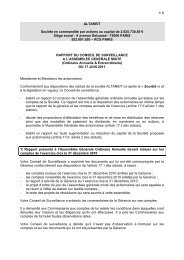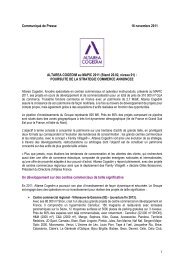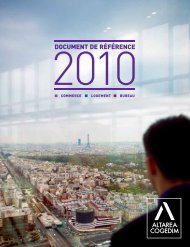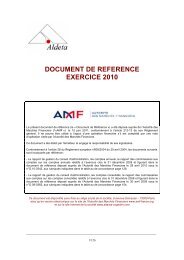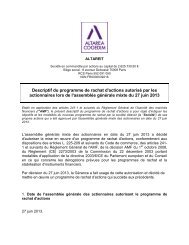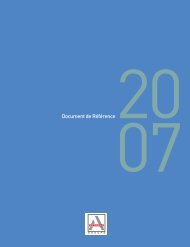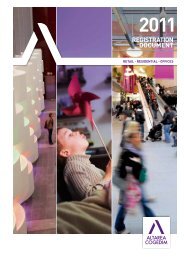Annual report 2008 - Altarea Cogedim
Annual report 2008 - Altarea Cogedim
Annual report 2008 - Altarea Cogedim
Create successful ePaper yourself
Turn your PDF publications into a flip-book with our unique Google optimized e-Paper software.
7.17. Trade receivables and other accounts<br />
receivable<br />
Trade receivables and other receivables are measured at<br />
face value less any allowances for impairment to reflect<br />
actual possibilities of recovery.<br />
For long-term contracts accounted for using the percentageof-completion<br />
method, this line item includes:<br />
• calls for funds issued but not yet settled by acquirers, for<br />
a completed percentage of work, and<br />
• the “amounts to be invoiced”, which correspond to calls<br />
for funds not yet issued under off-plan sale or property<br />
development contracts.<br />
7.18. Financial instruments<br />
The ALTAREA group adopted IAS 32 and 39 on 1 January<br />
2006 and IFRS 7 on 1 January 2007.<br />
The ALTAREA group has elected not to apply the hedge<br />
accounting proposed in IAS 39.<br />
At 31 December 2007, the principles of application of IAS<br />
32 and IAS 39 were as follows:<br />
a) Measurement and recognition of financial assets<br />
• The assets available for sale consist of equity securities of<br />
non-consolidated companies and are carried at fair value.<br />
If fair value cannot be determined reliably, the securities<br />
are carried at cost. Changes in fair value are recognised<br />
in equity, impairment losses in income and reversals in<br />
equity.<br />
• The portion of loans and advances to proportionately<br />
consolidated entities not eliminated on consolidation is<br />
recognised at amortised cost. If there is objective evidence<br />
of impairment on such loans and advances, an impairment<br />
loss is recognised in the income statement.<br />
• Derivative financial instruments are considered to be held<br />
for trading purposes. They are measured at fair value. The<br />
change in fair value of derivatives is recognised in the<br />
income statement.<br />
• The Group has no held-to-maturity assets.<br />
• Cash includes liquid assets in bank current accounts and<br />
holdings in money-market funds that are redeemable or<br />
tradable in the very short term (i.e., initial maturity of less<br />
than three months) and carry no significant risk of loss<br />
through fluctuations in interest rates. These assets are<br />
carried on the balance sheet at fair value. Changes in the<br />
fair value of these instruments are recognised in income,<br />
with a corresponding adjustment to cash.<br />
b) Measurement and recognition of financial liabilities<br />
• All borrowings and interest-bearing liabilities are initially<br />
recognised at the fair value of the amount received less<br />
directly attributable transaction costs. Thereafter, they are<br />
carried at amortised cost using the effective interest rate<br />
method. For this purpose, no assumption of prepayment<br />
before maturity was made. The initial effective interest<br />
rates were determined by an actuary. The effective interest<br />
rates were not reviewed given the backdrop of a decline in<br />
interest rates because the impact on the effective interest<br />
rates was not material.<br />
• Derivative financial instruments are considered to be<br />
held for trading purposes. They are measured at fair<br />
value. Changes in the fair value of these instruments are<br />
recognised in the income statement if the requirements<br />
for hedge accounting are not met.<br />
• The portion of borrowings and financial liabilities due in<br />
less than one year is shown under current liabilities.<br />
• Security deposits paid by shopping centre tenants are not<br />
discounted.<br />
c) Determination of the fair value of financial instruments<br />
(other than interest-bearing debt)<br />
Financial assets and liabilities are initially recognised at<br />
cost, which corresponds to the fair value of the price paid<br />
plus acquisition-related costs. After initial recognition, such<br />
assets and liabilities are recognised at fair value.<br />
For financial assets and liabilities such as listed shares that<br />
are actively traded on organised financial markets, fair value<br />
is determined by reference to the published market price at<br />
the balance sheet date.<br />
For other financial assets and liabilities such as OTC<br />
derivatives, swaps, caps, etc. that are traded on active<br />
markets (market composed of numerous transactions,<br />
continuously displayed and traded prices), fair value is<br />
estimated by an actuary using commonly accepted models.<br />
A mathematical model is used to bring together calculation<br />
methods based on recognised financial theories.<br />
As a last resort, the Group measures financial assets and<br />
liabilities at cost less potential impairment.<br />
The net realisable value of financial instruments may differ<br />
from the fair value calculated at the balance sheet date of<br />
each financial year.<br />
93



